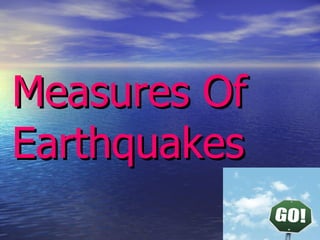
Measures of earthquakes
- 3. The Richter scale was invented, logically enough, in the 1930s by Dr. Charles Richter , a seismologist at the California Institute of Technology. It is a measure of the largest seismic wave recorded on a particular kind of seismograph located 100 kilometers (about 62 miles) from the epicenter of the earthquake. Think of a seismograph as a kind of sensitive pendulum that records the shaking of the Earth. The output of a seismograph is known as a seismogram. In
- 4. Different of intensty of eartquakes
- 5. the early days, seismograms were produced using ink pens on paper or beams of light on photographic paper, but now it's most often done digitally using computers. The seismograph that Dr. Richter used amplified movements by a factor of 3000, so the waves on the seismograms were much bigger than those that actually occurred in the Earth. The epicenter of an earthquake is the point on the Earth's surface directly above the source, or focus, of the movement that causes the quake.
- 6. Dr. Richter studied records from many earthquakes in southern California, and realized that some earthquakes made very small waves whereas others produced large waves. So, to make it easier to compare the sizes of the waves he recorded, Richter used the logarithms of the wave heights on seismograms measured in microns (1/1,000,000th of a meter, or 1/1000th of a millimeter). Remember, you have to be using a particular kind of seismograph located 100 km from the epicenter when you make the measurement; otherwise, all sorts of complicated calculations have to be made. That's why seismologists spend so many years in college!
- 7. A wave one millimeter (1000 microns) high on a seismogram would have a magnitude of 3 because 1000 is ten raised to the third power. In contrast, a wave ten millimeters high would have a magnitude of 4. For reasons that we won't go into, a factor of 10 change in the wave height corresponds to a factor of 32 change in the amount of energy released during the earthquake. In other words, a magnitude 7 earthquake would produce seismogram waves 10 x 10 = 100 times as high and release energy 32 x 32 = 1024 times as great as a magnitude 5 earthquake. The Richter scale is open-ended, meaning there is no limit to how small or large an earthquake might be. Due to the nature of logarithms, it is even possible to have earthquakes with negative magnitudes, although they are so small that humans would never feel them. At the other end of the spectrum, there should never be an earthquake much above magnitude 9 on the Earth simply because it would require a fault larger than any on the planet. The largest earthquake ever recorded on Earth was a magnitude 9.5 that occurred in Chile in 1960, followed in size by the 1964 Good Friday earthquake in Alaska (magnitude 9.2), a magnitude 9.1 earthquake in Alaska during 1957, and a magnitude 9.0 earthquake in Russia during 1952. Two large earthquakes, one a magnitude 9.0 and one a magnitude 8.2, occurred on Dec. 26, 2004 and March 28, 2005, respectively, along the same fault zone off the coast of Sumatra, Indonesia.
- 10. Earthquake intensity is most often measured using the modified Mercalli scale , which was invented by the Italian geologist Giuseppi Mercalli in 1902 and uses Roman numerals from I to XII. In the United States, we use the modified Mercalli scale, which was adjusted to account for differences in buildings between Italy and southern California. An earthquake intensity of I is generally not felt, and an intensity of XII represents total destruction of buildings. Some kinds of geologic deposits, most notably water saturated muds, amplify seismic waves and may produce intensities much greater than those for nearby areas underlain by bedrock. Thus, after an earthquake seismologists can interview people and make maps showing the intensity of an earthquake in different areas to better understand the influence of rock or soil type on seismic waves
- 11. يختلف تاثير الزلزال باختلاف شدته واليكم بعض الصورلتاثير الزلزال
- 21. Thank you faculty of engineerring civil engineering student/ Fathia Fawzy Wagdy Elkafrawy